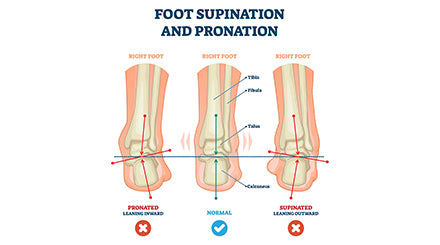
How to Know Your Pronation and the Support You Need
Pronation – this is a term that we hear repeatedly in relation to foot health, but do you know explicitly what this phrase refers to? It is the natural inclination for your foot to roll inwards as it strikes the ground, distributing the shock across the surface. When executed correctly, this is actually beneficial to your podiatric health; however, when performed to excess or not enough, improper amount of pronation can lead to a host of problems. Correct arch support plays a crucial role in order to prevent the foot, ankle, knee, and back discomfort that commonly accompanies this condition. Below are tips to help indicate what specific kind of insoles will best benefit your individual gait.
Normal Pronation:
Normal pronators generally have an S-shaped wear pattern from the outer part of the heel to the big toe. They can comfortably wear an extensive range of shoes. However, specialized footwear or insoles that are designed for neutral pronators can give additional support and cushioning.
Underpronation:
Also referred to as supination, underpronation is characterized by the foot’s natural inability to healthily roll inward. This results in an increased amount of stress being transmitted to your lower legs. Those that suffer from this condition will notice disproportionate signs of deterioration on your footwear’s outer heels.
Underpronators are particularly susceptible to stress fractures and other types of injuries related to excess shock. The best type of shoes for this are ones that provide extra cushioning to lessen the amount of impact that is felt when crossing hard surfaces. Lynco has insoles that are designed to provide added padding to provide relief to aching extremities.
Overpronation:
Excessive inward rolling of the feet is referred to as overpronation. When this happens, the majority of your weight actually transfers to the inside edge of the foot. Thus, the inner part of the structure bears most of the load rather than the ball of the foot. This action destabilizes your feet and, by extension, your hips and knees. It often spurs such painful conditions as Plantar Fasciitis and Achilles tendonitis.
Upon inspection, an overpronator’s shoes will reveal noticeable erosion inside the heel as well as excessive wear underneath the ball of the foot and the big toe. The best shoes for an overpronator feature maximum support, as well as supplementary cushioning. Vionic is a brand that is particularly well suited for overpronators.
While you can figure out your pronation pattern on your own at home, it is recommended that you also consult with a foot expert. It may be helpful to bring in an older pair of your shoes so the medical professional can see firsthand which parts of the insoles are experiencing the most wear and tear. Therefore, your podiatrist can make an informed recommendation to you, empowering you to experience movement that is without unhealthy pronation and discomfort.
Resources:
http://www.runnersworld.com/running-shoes/take-wet-test-learn-your-foot-type
http://www.asics.co.uk/running/knowledge/understanding-pronation/
http://www.runningwarehouse.com/learningcenter/pronationfaq.html
http://www.sportsinjuryclinic.net/sport-injuries/foot-heel-pain/overpronation
